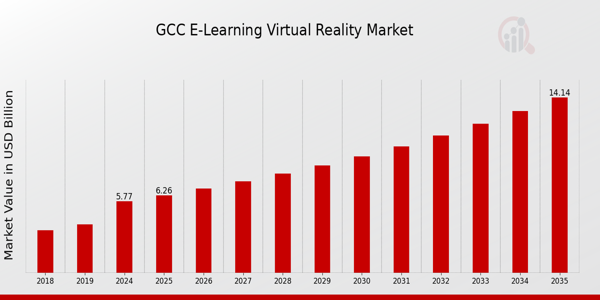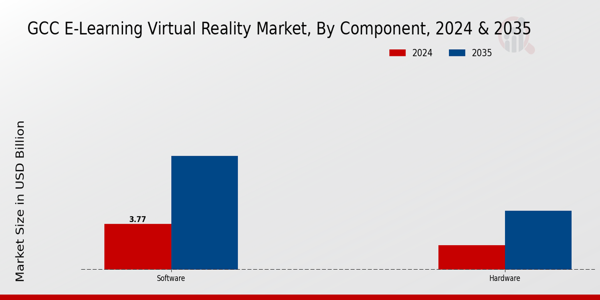GCC E-Learning Virtual Reality Market Overview
As per MRFR analysis, the GCC E-Learning Virtual Reality Market Size was estimated at 5.28 (USD Billion) in 2023.The GCC E-Learning Virtual Reality Market is expected to grow from 5.77(USD Billion) in 2024 to 14.14 (USD Billion) by 2035. The GCC E-Learning Virtual Reality Market CAGR (growth rate) is expected to be around 8.49% during the forecast period (2025 - 2035).
Key GCC E-Learning Virtual Reality Market Trends Highlighted
The GCC E-Learning Virtual Reality Market is experiencing significant growth driven by several key market drivers. The increasing adoption of technology in education, particularly during the pandemic, has accelerated the integration of virtual reality into learning environments. Educational institutions across the GCC are focusing on enhancing student engagement and improving learning outcomes, leading to greater investment in immersive e-learning solutions.
This trend aligns with the region's commitment to advancing knowledge-based economies, as highlighted by various national strategies aimed at educational reform and innovation in countries like the UAE and Saudi Arabia.There are many chances to be explored in this market as more and more people want personalized learning experiences. Virtual reality has some unique benefits because it lets you experience simulations and environments that are interesting and work for different types of learners.
As more and more educational institutions work together with tech companies, it becomes easier to create VR content that is tailored to the needs of specific students. Also, since governments are putting more emphasis on digital skills like coding and data analysis, there is a clear need for e-learning platforms that use VR to teach these skills well. Recent trends show that more and more people are using blended learning models, which mix traditional education with virtual reality experiences.
This hybrid approach allows institutions to operate more efficiently while maintaining high-quality education standards. Additionally, recent initiatives by the Gulf Cooperation Council to promote STEAM (Science, Technology, Engineering, Arts, and Mathematics) programs highlight the importance of integrating innovative teaching methods, including VR. As more educational professionals advocate for the benefits of VR in training and development, the GCC E-Learning Virtual Reality Market is poised for further expansion, driven by a clear vision for modernizing education in the region.

Source: Primary Research, Secondary Research, Market Research Future Database, and Analyst Review
GCC E-Learning Virtual Reality Market Drivers
Increasing Government Initiatives in Education Technology
The Gulf Cooperation Council (GCC) governments are actively promoting the integration of technology in education, especially in the wake of the COVID-19 pandemic. The Ministry of Education in the United Arab Emirates (UAE) has introduced various initiatives to enhance digital learning environments as part of its National Strategy for Advanced Industries, which aims to attract investments in educational technologies.
For instance, the GCC E-Learning Virtual Reality Market is poised for growth as initiatives such as the Smart Learning Program in Dubai, which aims to provide advanced technological tools to students, are projected to benefit educational institutions by incorporating innovative solutions.Reports indicate that educational institutions adopting blended learning models witness a 25% increase in student engagement, thereby validating the efficacy of such government initiatives.
Rising Demand for Personalized Learning Experiences
With the surge in online education, there is an escalating demand for personalized learning experiences among students in the GCC region. According to the Gulf Education and Training Exhibition findings, a substantial 67% of students surveyed expressed interest in customized learning pathways that cater to their unique learning styles and paces.
The GCC E-Learning Virtual Reality Market can leverage this demand by utilizing Virtual Reality (VR) technologies, which allow for immersive and tailored educational experiences.Prominent universities, such as Qatar University, have begun implementing VR solutions in their curricula, contributing to increased student satisfaction and enhancing academic performance with reported improvements of up to 30% in test scores.
Growing Investment in Research and Development
Significant investments in Research and Development (R&D) in the educational sector within the GCC region are expected to drive the growth of the E-Learning Virtual Reality Market. For instance, in Saudi Arabia, the government announced a substantial allocation to enhance educational technologies, including VR, which is outlined in its Vision 2030 plan.
This strategic investment is reflected in the growth of educational start-ups adopting VR technology, which has increased by approximately 50% over the past three years.Such investment fosters innovation and fuels the development of cutting-edge VR content, positioning the GCC E-Learning Virtual Reality Market favorably for future expansion.
Increased Internet Penetration and Smartphone Access
The rapid increase in internet penetration across the GCC region is a significant driver for the E-Learning Virtual Reality Market. As reported by the Telecommunications Regulatory Authority in the UAE, internet use has reached 99% among residents, providing a solid foundation for the adoption of e-learning solutions.
This strong internet infrastructure supports the uptake of Virtual Reality applications in education, significantly enhancing accessibility and user engagement.Furthermore, with smartphone access surpassing 90% of the population, the potential for mobile VR applications is substantial. This booming accessibility facilitates the dissemination of the GCC E-Learning Virtual Reality Market, as consumers increasingly demand more interactive educational experiences on mobile platforms.
GCC E-Learning Virtual Reality Market Segment Insights
E-Learning Virtual Reality Market Component Insights
The GCC E-Learning Virtual Reality Market, particularly focusing on the Component segment, demonstrates notable diversity and significant growth potential driven by technological advancements and increasing adoption within educational frameworks. In recent years, the demand for immersive learning experiences has amplified, prompting educational institutions to integrate virtual reality into their training programs. The Component market is primarily divided into two critical areas: Hardware and Software, both playing pivotal roles in delivering effective e-learning solutions.
The Hardware aspect encompasses devices such as VR headsets, sensors, and motion trackers, which are essential for creating an immersive learning environment. This segment is dominating due to the rapid advancement of technology in the region, with educational authorities and institutions investing heavily in state-of-the-art infrastructure to facilitate VR-based learning. The significant user engagement and ability to replicate real-life scenarios make hardware integral for enhancing the learning experience. On the other hand, the Software segment provides the necessary content and applications to utilize the hardware efficiently.
This segment includes platforms for creating virtual learning modules, simulations, and interactive environments tailored specifically for different educational levels and subjects. Software solutions are increasingly focusing on user-friendly interfaces and interactive elements to enhance learner participation and retention. The rising emphasis on personalized learning experiences drives the software market segment, aligning with the GCC's goals of improving educational outcomes and catering to diverse student needs.
Both segments face unique challenges, such as high costs of implementation and the need for continuous updates to keep pace with technological advancements. Nevertheless, the ongoing digital transformation in the GCC education landscape, supported by government initiatives aiming to enhance technology integration, provides ample opportunities for both Hardware and Software components to thrive.
As initiatives like the GCC Education Strategy prioritize technology in classrooms, the demand for innovative VR solutions in e-learning continues to grow, underscoring the importance of these components in shaping the future of education in the region. Thus, while both segments of Component are individually crucial, their combined effectiveness defines the efficacy and success of the GCC E-Learning Virtual Reality Market, contributing significantly to overall market dynamics.

Source: Primary Research, Secondary Research, Market Research Future Database, and Analyst Review
E-Learning Virtual Reality Market Technology Insights
The GCC E-Learning Virtual Reality Market showcases significant growth within the Technology segment, reflecting a shift towards advanced learning methodologies. This segment includes varying experiences fundamental to engaging users, with Non-Immersive solutions providing accessibility and ease of use, while Fully Immersive experiences deliver unparalleled interaction and simulation.
These distinct approaches cater to diverse training requirements across industries such as healthcare, aviation, and education, enhancing skill acquisition and retention.The increasing integration of technology in educational frameworks, backed by supportive government initiatives aimed at improving digital learning, further populates the GCC landscape.
With a rising demand for immersive educational experiences, both Non-Immersive and Fully Immersive sectors play crucial roles in creating engaging learning environments, thus driving the evolution and adoption of innovative educational tools across the region. The GCC's focus on digital transformation and modernization of its educational ecosystem presents exciting opportunities for growth within this segment, ensuring that technology continues to redefine traditional learning experiences effectively.
E-Learning Virtual Reality Market Application Insights
The Application segment of the GCC E-Learning Virtual Reality Market showcases significant growth potential, driven by the rising adoption of immersive technology in education and corporate training. Academic institutions in the GCC region have increasingly integrated virtual reality to enhance student engagement and facilitate interactive learning environments. This approach not only aids in knowledge retention but also bridges the gap between theoretical concepts and practical applications.
On the corporate front, organizations recognize the value of virtual reality for training and development, offering diverse application opportunities such as simulations for skills training, leadership development, and team-building exercises. By providing immersive experiences, companies can improve workforce training efficiency and reduce costs associated with traditional training methods.
The combination of these factors fosters an environment ripe for innovation and investment, propelling the growth of the overall GCC E-Learning Virtual Reality Market. This evolving landscape indicates a robust participation of both academic and corporate segments, underlining their importance in shaping the future of learning in the region.
GCC E-Learning Virtual Reality Market Key Players and Competitive Insights
The GCC E-Learning Virtual Reality Market has become increasingly competitive as technological advancements and digital transformation drive educational institutions and corporate training environments to adopt innovative learning solutions. The integration of virtual reality into e-learning platforms enhances user engagement and creates immersive experiences that facilitate better understanding and retention of information. Within this dynamic marketplace, numerous companies strive to capitalize on the growing demand for VR-based educational content, tools, and services.
The competitive landscape is characterized by a mix of established firms and emerging startups, each offering unique products and capabilities targeted at various segments, including K-12, higher education, and professional training. Blackboard holds a significant position in the GCC E-Learning Virtual Reality Market due to its established brand reputation and comprehensive suite of educational tools.
The company focuses on innovating its offerings to enhance user experience, facilitating interactive learning through virtual reality applications that cater to diverse learning environments. With a strong presence in the region, Blackboard leverages its existing relationships with educational institutions to promote the adoption of its VR solutions.
The company’s strengths lie in its technology infrastructure, which is designed to support scalable and flexible e-learning platforms, thus enabling educators to create tailored virtual learning experiences. Blackboard's commitment to continuous improvement and integration of cutting-edge technology positions it favorably in the competitive landscape, appealing to educational entities looking to enhance their curricula with modern learning methodologies.
Viveport, another key player in the GCC E-Learning Virtual Reality Market, offers a dedicated platform that serves educational institutions seeking to harness the potential of virtual reality in their teaching methods. Viveport's extensive catalog of VR content is tailored to various educational needs, providing a rich resource for educators looking to implement immersive experiences in their classrooms.
The company enjoys a strong market presence due to its commitment to developing innovative solutions that resonate with the GCC education sector. Viveport’s strengths include a user-friendly interface and the ability to integrate with existing educational technologies, making its products accessible to a broad range of learners. In recent years, Viveport has also made strategic moves through partnerships and collaborations aimed at expanding its footprint in the GCC region. These initiatives help to enrich its offerings and provide a competitive edge as it continues to evolve alongside the growing demand for virtual reality in education within the region.
Key Companies in the GCC E-Learning Virtual Reality Market Include
- Blackboard
- Viveport
- Microsoft
- Udacity
- Samsung Electronics
- Talview
- Coursera
- Edmodo
- Moodle
- Instructure
- Pearson
- Unity Technologies
- Google
- FutureLearn
- Khan Academy
GCC E-Learning Virtual Reality Market Developments
In recent months, the GCC E-Learning Virtual Reality Market has seen significant growth and innovation, driven by technological advancements and increased demand for immersive learning experiences. Companies like Blackboard and Talview are at the forefront, expanding their platforms to incorporate Virtual Reality features that enhance student engagement and understanding.
Microsoft's investments in Virtual Reality tools further amplify the market's potential, especially within educational institutions in the UAE and Saudi Arabia. In October 2023, Coursera announced a partnership with local universities to provide Virtual Reality courses aimed at upskilling the workforce, which reflects the alignmentof educational offerings with regional labor market demands.
Additionally, Samsung Electronics continues to explore educational applications of its Virtual Reality technologies to foster hands-on learning experiences. The market's valuation has grown substantially, particularly as educational entities increasingly recognize the importance of innovative learning solutions. Over the past two to three years, significant events such as the introduction of VR-based curricula in several GCC schools since early 2022 have reshaped educational methodologies, emphasizing a blend of technology and traditional learning modalities.
GCC E-Learning Virtual Reality Market Segmentation Insights
-
E-Learning Virtual Reality Market Component Outlook
-
E-Learning Virtual Reality Market Technology Outlook
- Non-Immersive
- Fully Immersive
-
E-Learning Virtual Reality Market Application Outlook
| Report Attribute/Metric Source: |
Details |
| MARKET SIZE 2023 |
5.28(USD Billion) |
| MARKET SIZE 2024 |
5.77(USD Billion) |
| MARKET SIZE 2035 |
14.14(USD Billion) |
| COMPOUND ANNUAL GROWTH RATE (CAGR) |
8.49% (2025 - 2035) |
| REPORT COVERAGE |
Revenue Forecast, Competitive Landscape, Growth Factors, and Trends |
| BASE YEAR |
2024 |
| MARKET FORECAST PERIOD |
2025 - 2035 |
| HISTORICAL DATA |
2019 - 2024 |
| MARKET FORECAST UNITS |
USD Billion |
| KEY COMPANIES PROFILED |
Blackboard, Viveport, Microsoft, Udacity, Samsung Electronics, Talview, Coursera, Edmodo, Moodle, Instructure, Pearson, Unity Technologies, Google, FutureLearn, Khan Academy |
| SEGMENTS COVERED |
Component, Technology, Application |
| KEY MARKET OPPORTUNITIES |
Immersive training simulations, Interactive language learning platforms, Enhanced corporate training solutions, Remote education for underserved areas, Partnerships with educational institutions |
| KEY MARKET DYNAMICS |
growing adoption of technology, increasing demand for immersive learning, government initiatives in education, rising investment in startups, expanding internet penetration |
| COUNTRIES COVERED |
GCC |
Frequently Asked Questions (FAQ):
The GCC E-Learning Virtual Reality Market is expected to be valued at 5.77 USD Billion in 2024.
By 2035, the market is projected to reach a value of 14.14 USD Billion.
The expected CAGR for the market during this period is 8.49%.
The hardware segment is projected to be valued at 4.82 USD Billion by 2035.
The software segment is expected to be valued at 3.77 USD Billion in 2024.
Key players in the market include Blackboard, Microsoft, Coursera, and Samsung Electronics among others.
The increasing demand for interactive and immersive learning experiences is driving market growth.
Challenges include high initial costs of VR technology and the need for robust content development.
Key applications include training simulations, educational courses, and virtual labs.
Regional education policies promoting digital learning initiatives enhance the market's growth potential.
















